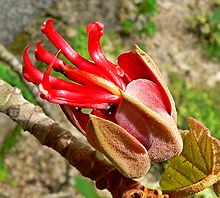Chiranthodendron pentadactylon
| Chiranthodendron pentadactylon | ||||||||||||
|---|---|---|---|---|---|---|---|---|---|---|---|---|

Chiranthodendron pentadactylon |
||||||||||||
| Systematics | ||||||||||||
|
||||||||||||
| Scientific name of the genus | ||||||||||||
| Chiranthodendron | ||||||||||||
| Larreat. | ||||||||||||
| Scientific name of the species | ||||||||||||
| Chiranthodendron pentadactylon | ||||||||||||
| Larreat. |
Chiranthodendron pentadactylon (in German also "hand tree") is the only kind of monotypic genus Chiranthodendron within the family of mallow (Malvaceae).
The tree is called "árbol de las manitas" (directly translated tree of little hands ) in Spanish, "mācpalxōchitl" ( hand flower ) in Nahuatl and "Devil's", "Monkey's" or "Mexican hand tree" ( devil , monkey or Mexican hand tree ) or "hand flower" ( hand flower ) in English, because the red flowers look like hands.
Distribution and description
Chiranthodendron pentadactylon grows as a tree up to 20–30 meters high. The trunk diameter reaches 1–2 meters.
Chiranthodendron pentadactylon is native to southern Mexico and Guatemala . The tree has been introduced to many parts of the world, mainly North America , because of its peculiar appearance .
The simple, long-stalked, more or less heart-shaped leaves are large and more or less 5–7 times lobed. They are broadly ovate to rounded and 12-30 centimeters in size, the lobes are rounded to pointed and they are hairy on the underside. The nerve is palmate.
The flowers appear axillary and solitary. They are underlaid by cover sheets . The large, five-fold flowers have a simple perimeter , the petals are missing. The thick, fleshy, pointed and flabby, basal fused sepals are keeled on the outside, red-brownish hairy, fine-black and inside red, glabrous. The sepals have inside at the base a nectarium in a pit, bulge. The tubular, fused, large, fleshy and red stamens are free in the upper part, with thick, awl-like, somewhat curved stamens with two elongated anthers on the outside. They resemble an outstretched hand. The five-chamber ovary is on top with a thick, long and conical stylus that grows out through the upper hole of the staminal tube.
Five-ribbed, five-lobed, hairy and brown, many-seeded, loculicidal, about 10-15 centimeters long, hard, woody capsule fruits are formed. The small black, leathery seeds have an orange strop .
use
The Aztecs and others used the plant as a remedy for abdominal pain and heart problems. Solutions from the leaves can also lower blood cholesterol levels; they also work as diuretics because they contain the glycosides quercetin and luteolin .
literature
- Flora of Guatemala. Fieldiana, Vol. 24, Part VI, 1949, pp. 407 ff, online at biodiversitylibrary.org.
Web links
- Photos Chiranthodendron pentadactylon flower canac manitas Aztec cacao chocolate flavoring medicine on maya-ethnobotany.org.
- First description by José Dionisio Larreátegui at Smithsonian Libraries.
Individual evidence
- ^ Elizabeth McClintock: The trees of Golden Gate Park and San Francisco , edited by Richard Turner, 2001, ISBN 1-890771-28-7 , p. 65.
- ^ Karl Schumann : Textbook of Systematic Botany, Phytopalaeontology, and Phytogeography. Published by Ferdinand Enke, Stuttgart, 1894, p. 427.
- ↑ Real Encyclopedia of All Pharmacy. Second, completely revised edition, 3rd volume, edited by Josef Moeller and Hermann Thoms , Berlin and Vienna, 1904, p. 625.
- ↑ a b Emory Dean Keoke, Kay Marie Porterfield: Encyclopedia of American Indian Contributions to the World. 2002, ISBN 0-8160-4052-4 , page 118: "For lower abdominal pain, the patient would be prescribed macpalxochitl ( Chiranthodendron )".
- ↑ 'Flor de manita' (Chiranthodendron pentadactylon Larr.), A highly prized and effective heart remedy, is available fresh during the winter months. In: Journal of Ethnobiology , edited by The Center for Western Studies (Flagstaff, Arizona), Volume 3, 1983.
- ^ A b Nina L. Etkin: Eating on the Wild Side: The Pharmacologic, Ecologic and Social Implications of Using Noncultigens. Univ. of Arizona Press, 1994, ISBN 0-8165-1369-4 , page 26: "The Aztec also used the blossoms of the hand-flower tree ( Chiranthodendron pentadactylon ) as a blood or heart tonic. [...] water-based solutions of the flowers reduce edema and serum cholesterol levels (Jiu 1966). [The tree ...] also acts as a diuretic (due to the glycosides quercetin and luteolin) and, when ingested regularly as a decocted beverage, is most likely effective in treating cardiopulmonary insufficieny (Logan 1981). "
